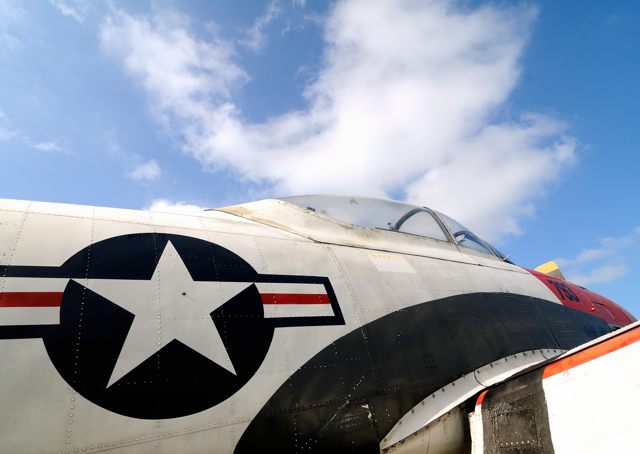
Lee Griffin of North Pole, Alaska, recently realized a dream he’s had since 1991 when he made his first-ever visit to EAA AirVenture. And he made the trip in the North American T-28 Trojan he’s owned since August 1991.
The approximately 2,600-nautical-mile trip took 18.7 flight hours and about 750 gallons of fuel over four days. Griffin, 69, was accompanied by Jeff Cornett, his crew chief and a rated pilot in the T-28.
 “The first two-thirds of the trip down, through Canada, was miles of nothing but miles and miles,” Griffin said. Mountains, forests, lakes—repeat. “And then eventually, once you get down around Dawson Creek, you get farm fields. Our longest leg was Fairbanks to Whitehorse, and it was 3.2 hours. We got weathered in one day at Dawson Creek,” in British Columbia, Canada, where he said the local weather was good but conditions at their next stop were not. “We wanted to do a little maintenance on the airplane anyway.”
“The first two-thirds of the trip down, through Canada, was miles of nothing but miles and miles,” Griffin said. Mountains, forests, lakes—repeat. “And then eventually, once you get down around Dawson Creek, you get farm fields. Our longest leg was Fairbanks to Whitehorse, and it was 3.2 hours. We got weathered in one day at Dawson Creek,” in British Columbia, Canada, where he said the local weather was good but conditions at their next stop were not. “We wanted to do a little maintenance on the airplane anyway.”
Griffin had flown that section of the Alaska-Siberian air road—used during World War II to ferry Lend-Lease aircraft from the United States to Russia for use in combat on the war’s Eastern Front—several times in the 1970s, flying Citabrias, Super Cubs, and a Cessna 172. “But I’d never flown it from north to south,” he said.
AirVenture was worth the trip, Griffin said. “I was like a kid in a candy store. Because I wasn’t feeling 100 percent, I didn’t get to all of the venues and all of the exhibits.” And at airshows, he prefers to hang around his airplane so he can greet visitors and talk about the former Navy trainer once owned by the state of Alaska. “That’s just one of the things I like to do, and I did a lot of that.”
Griffin was treated for adenocarcinoma of the esophagus in 2000, and had been in remission until a month before AirVenture—when he was diagnosed with signet ring cell adenocarcinoma of the stomach. From Oshkosh he and Cornett flew to Texas, where Griffin will begin treatment at the University of Texas MD Anderson Cancer Center. “It’s a really, really good team down there. I couldn’t be in better hands,” he said.
 Bitten by the airplane bug early, Griffin wanted to be an Air Force fighter pilot but flunked the flight physical; instead, he ended up in Thailand as an armorer. “I was the line loading officer for the 44th Tactical Fighter Squadron, which was the Wild Weasel squadron,” explained Griffin, who supervised the arming with bombs, missiles, and ammunition of the F-105s used on the high-risk mission to knock out enemy surface-to-air missiles. Later he served as Civil Air Patrol liaison officer for the northern half of Alaska, and in the Air National Guard as a KC-135 crew chief. Now he works full-time as an environmental scientist for the Army at Fort Wainwright, Alaska.
Bitten by the airplane bug early, Griffin wanted to be an Air Force fighter pilot but flunked the flight physical; instead, he ended up in Thailand as an armorer. “I was the line loading officer for the 44th Tactical Fighter Squadron, which was the Wild Weasel squadron,” explained Griffin, who supervised the arming with bombs, missiles, and ammunition of the F-105s used on the high-risk mission to knock out enemy surface-to-air missiles. Later he served as Civil Air Patrol liaison officer for the northern half of Alaska, and in the Air National Guard as a KC-135 crew chief. Now he works full-time as an environmental scientist for the Army at Fort Wainwright, Alaska.
Griffin said his T-28, Bub—for Big, Ugly Beast—is currently the only flying Trojan in Alaska. It was one of six the state acquired to use as lead-in aircraft for borate bombers; some had come from the Pensacola flight line but most had been in storage at Davis-Monthan Air Force Base in Arizona. “About 10 years later, the state decided they couldn’t afford to operate the airplanes, which should have been a big hint—but I’m not too bright,” he laughed.
Bub flew in 1998, after seven years of hard work. The airplane has been in continuous refurbishment ever since. “It got all new avionics as I could afford it, and there’s been a lot of removing and replacing,” said Griffin, who just completed phase five of what he thinks will be a seven-phase rewiring project.
He had hoped to make the Oshkosh trip last year, accompanied by Alex Mumley-Dupuis in a Citabria as part of an effort to raise funds for wounded warriors (see “Flight for a cause” in the August 2014 AOPA Pilot), but those plans were scuttled by a generator failure warning light as he taxied out to depart for Wisconsin.
Now that he’s finally made his first visit, however, Griffin is already looking forward to a return visit next year.



